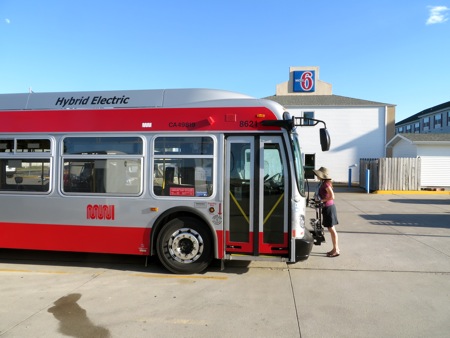After we ate breakfast, Carol and her aunt wanted to spend the morning talking about family. I went for a walk along the Auld-Brokaw bike path in Yankton. It was pleasant enough when you could feel the wind, but when I got to the Yankton high school, the path was in the lee of a hill, and there was no breeze at all, and it was quite hot. I was glad to get back to Carol’s aunt’s tree-shaded house. But she and her aunt were deep in family recollections, and I decided to visit the National Music Museum, which was just a few miles away.
The National Music Museum is housed on the campus of the University of South Dakota in Vermillion. I found a shady parking place down the street, and walked in. The pleasant woman at the front desk told me there was an audio tour available, but I said I only had an hour, and pretty much knew what I wanted to see. It took me a few minutes — I kept getting distracted by all the amazing and beautiful instruments on display — but pretty soon I found the mountain dulcimer made by J. E. Thomas in Kentucky in 1912. I had seen the instrument on their online checklist, and was pretty sure they would display an instrument by the traditional builder who had perhaps the greatest influence on the revival of the mountain dulcimer. Their instrument has some damage — it has a small crack in the soundboard, and one of the sides has separated from the soundboard at the lower bout — but it is still a good example of how Thomas made his instruments. I paid particular attention to the flat grain of the soundboard; the way the outer strings bore against the sides of the pegbox; the frets made of wire staples; the wooden nut and bridge. While well-made, this is a folk instrument, not a finely-crafted product of a luthier’s shop.
I also noticed a square piano made by John Osborne of Boston about 1824. I noticed this instrument because it had come from the Rotch-Jones-Duff House and Garden Museum in New Bedford, Massachusetts, as a transfer in 2012. The Rotch-Jones-Duff House had been refining its collection while I lived in New Bedford, and presumably the curators either decided that this piano had no real connection to the house, or that they couldn’t adequately care for it. In any case, it has found a lovely home, and it now stands back to back with another square piano from a different Boston piano maker of the early nineteenth century, allowing people to compare subtle details of the cabinetry between two similar instruments.
I tore myself away from the National Music Museum. I could have spent several more hours there, looking at all kinds of instruments: novelty ukuleles; an original theremin; tools, molds, jigs, and benches from a guitar maker’s shop; the same from a luthier’s shop; clavichords; serpents; an epinette des Vosges; a trumpet marine; an 1850s Martin guitar; etc. On my way out, I talked briefly with the woman at the front desk, and she said the museum hosts weekly concerts when school is in session, occasionally using instruments, particularly keyboard instruments, from the collections. For a certain kind of person, it would be worth a special trip to Vermillion, South Dakota, to go to the museum and attend one of those concerts.
We left Carol’s aunt’s house in the middle of the day, had a quick lunch in Yankton, and began driving due south on U.S. Route 81 towards Interstate 80. We crossed the river into Nebraska, and the road climbed up out of the flat river basin into rolling plains. Along with the fields of corn and soybeans we have been seeing ever since Ohio, we started seeing fields with cattle, fields of hay being cut, and other fields of hay already cut and now being baled. The two-lane highway rolled through the green fields, a few trees lining the creek beds or surrounding isolated farm houses, the giant irrigation structures spraying water. We stopped in Norfolk for gas, and bought the local newspaper, the Norfolk Daily News; the front page stories included the following lead paragraphs: “Nebraska has a new tool for fighting wildfires — a single engine air tanker that arrived in Valentine earlier this week.” — and — “An Omaha trial lawyer is making his way through the state, announcing his candidacy for U.S. Senate.”
We stopped in Grand Island, Nebraska, not long before we got back on the interstate. Carol went to buy some fruit juice at the Azteca Market, and I went across the street to The Tattered Page, a used book store. As I was looking through the books, I heard some guys talking about experience points and hit points, and later I saw books for gamers. I walked up to the cashier to buy a copy of Bret Harte’s stories — a former library book that was indeed somewhat tattered — and said to the cashier, “I like the combination of used books and role playing games.” He smiled, and another guy sitting nearby said, without looking up, “Give the people what they want!”
On the interstate, I saw what looked like a bus in front of us. It was a bus, and the lighted destination sign in back read “SF.” The color scheme of the bus looked familiar. As we passed it, we saw that it carried a familiar logo reading MUNI, and other signage proclaimed that it was a hybrid electric vehicle that used biofuels. “Look at that bus!” I said to Carol. We laughed out loud to see a San Francisco bus on the highway in the middle of Nebraska. Later, when we got to our motel in Kearney, we discovered to our delight that the bus was spending the night here as well:

